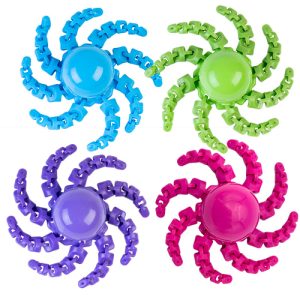Look. Touch. Listen. Smell. Taste.
These may seem just a few normal words, yet these senses are the essence of our life, which we often neglect to appreciate.
We will engage with the world via our senses in different ways. Further, some of us may face unique hurdles or limits to one or more senses. But we’ll all engage with the world primarily through our senses throughout our lives.
Today, several sensory play ideas and materials may be used to stimulate young children. Many of them help explore the essential characteristics of the five major senses as they grow in home and classroom environments.
These techniques often use a range of textures, substances, ingredients, and props. Combined, they provide an overall awareness and engagement of the primary senses.
Let’s understand more about sensory play, tactile toys, and how they can benefit your child.
What Are Tactile Toys?
Tactile toys, also known as sensory toys, are designed to engage the sense of touch and provide a range of tactile experiences for children. These toys can help children develop their fine motor skills, improve their cognitive development, and enhance their overall learning and development.
What Is Sensory Play & Why It Is Important?
Sensory play is a non-traditional approach to exploration and learning that allows a child to experience via all five senses.
Many embrace a more proactive position in enabling and supporting children to use their senses to acquire various abilities from the start of their life journey, resulting in an increase in the prevalence of sensory play in several situations and settings.
All children must sense, see, taste, touch, and listen to gain knowledge. However, as a child develops, educational settings need more reading and writing, which may be challenging and stressful for young kids who are still starting to talk and listen.
Most youngsters have difficulty sitting still for extended periods. Sensory play engages children actively as they discover different textures, tastes, and sounds.
Why is sensory play so important? The main reason is it is essential for your child’s development. It stimulates all the senses and broadens a kid’s vision of the environment. Children acquire knowledge via their senses by touching, tasting, seeing the facial expressions of others, listening to noises, and conversing with others.
Sensory play may provide youngsters with the chance to develop individual abilities such as:
- Social skills
- Communication and linguistic abilities
- Sensory and gross motor skills
- Fine motor skills
- Cognitive talents
Additionally, it promotes children’s:
- Brain development
- Cognitive development
- Scientific rationale
- Sensory maturation
- Vestibular system
Sensory play is helpful for all children but may be beneficial for children with intellectual impairments.
Now, let’s understand the benefits of sensory play.
The Benefits Of Sensory Play
Regardless of the child’s age, developmental stage, or learning style, all children will gain from sensory stimulation and play-based learning. So these are as follows:
1. Promotes physical development:
Sensory toys that involve the sense of touch can help children develop their fine motor skills. For example, grasping toys that require fingers and hands can improve a child’s hand-eye coordination and dexterity.
2. Enhances cognitive development:
Sensory play can help children explore and learn about the world around them. Through play, children can learn about different textures, shapes, and sizes, which can help them understand and make sense of their surroundings.
3. Encourages creativity:
Sensory toys that allow children to explore and create can help spark their creativity and imagination. For example, clay and play dough provide a malleable and tactile medium for children to shape and mould into various forms.
4. Increases language development:
Sensory play can help children learn new words and expand their vocabulary. For example, using toys with different textures can help children learn words such as “smooth,” “rough,” and “slippery.”
5. Reduces stress:
Sensory play can be a calming and therapeutic activity for children, helping to reduce stress and anxiety. For example, sensory toys such as stress balls or weighted blankets can help children relax and feel calm.
6. Improved focus and concentration
A key advantage of sensory play is increased attention and focus since the child must listen closely for clues to complete the story. Hence, this aids in the development of multitasking abilities, as children retain focus on the tale instead of being readily distracted by other activities.
7. New and varied sensory experiences
Various sensory activities stimulate various senses. Every day, children may learn something new about themselves and the world if exposed to abundant experiences and a wide range of fresh and unique difficulties.
8. Sensory exercises help youngsters learn about differences and features
When it involves learning about colour, sensory play creates the circumstances for discovering the contrasts between hues. Additionally, children learn about the characteristics of an item or concept using their senses.
9. Sensory play is suitable for any location, whether inside or outdoors.
A child’s senses may be stimulated by a plethora of experiences that are readily accessible in the natural world. It also lends itself well to messy play outdoors. However, it is possible to experience messy play inside while maintaining a safe or clean home.
When your youngster participates in messy play, use an old plastic tablecloth to protect the table and floor surfaces. A terrific place for messy play is the kitchen sink or bathtub, especially if paint or water are involved. The organisation of loose things is facilitated by sensory tubs and bins.
Conclusion
There is no exact technique for your children to participate in sensory play since each child is distinct and different activities promote various types of development. Consider employing a variety of sensory toys and easy activities that will stimulate their brain and, most importantly, enable them to have fun. Although it can be tempting to depend on children’s television to educate them about vision, sound, and other concepts, sometimes the physical play can be the most effective method.
We at Sister Sensory offer a range of sensory toys that help to improve motor and social skills and facilitate learning. So, browse our store and check our range of sensory toys that can be helpful for your child.







